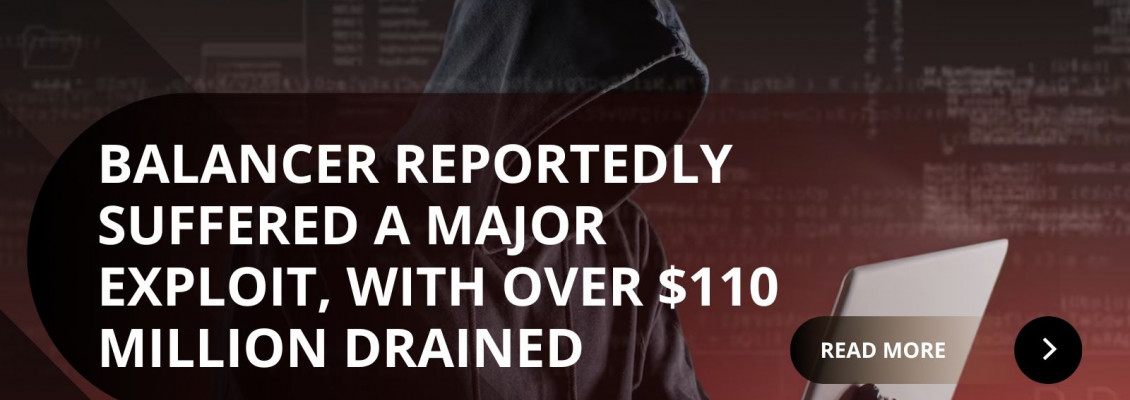
Balancer Faces Over $110 Million in Outflows After Potential Exploit
The decentralized finance (DeFi) protocol Balancer is facing scrutiny after more than $110 million in assets were drained from its pools in what appears to be a large-scale exploit. Early reports surfaced from blockchain analysts, including @AdiFlips on X, who tracked the initial transactions and raised alarm over millions of dollars in outflows from Balancer’s smart contracts.
What Happened
Balancer’s smart contracts began showing suspicious transactions involving Wrapped Ether (WETH), Lido staked Ether (wstETH), and Origin staked Ether (osETH) on October 30. According to on-chain data shared by @AdiFlips, the transactions originated from Balancer’s “manageUserBalance” function, a part of its V2 smart contract system that handles user funds and pool accounting.
In just a few minutes, an unknown address moved more than $70 million worth of assets across multiple transactions. Follow-up analysis by several DeFi monitoring platforms later confirmed that total outflows exceeded $110 million, with funds being consolidated into a single wallet.
What the Analyst Found
On X, @AdiFlips posted the first thread highlighting the exploit, noting that the “manageUserBalance” function was being abused. He showed that the attacker was able to call the function in a way that bypassed standard permission checks, allowing them to drain funds from liquidity pools without ownership validation.
In his breakdown, he wrote:
“It looks like the Balancer exploit is real. Someone managed to bypass
msg.sendervalidation in themanageUserBalancefunction, allowing them to transfer tokens directly. Funds are being drained quickly.”
His real-time tracking of the attacker’s wallet provided the first public warning to liquidity providers (LPs), prompting many to start pulling funds before further losses.
Balancer’s Response
Balancer confirmed the issue shortly after the exploit began, posting an update on X:
“We are aware of a potential exploit impacting Balancer V2 pools. Our engineering and security teams are investigating with high priority.”
The team said it has contacted major blockchain security groups and forensic analysts to trace the funds and assess the exploit’s scope. Balancer has also offered a 20% white-hat bounty for the return of the stolen assets, promising leniency if the attacker cooperates.
If the funds are not returned within 48 hours, Balancer stated it would pursue the matter through law enforcement and deeper blockchain forensics, including cross-referencing IP, ASN, and timestamp data linked to on-chain activity.
How the Exploit Worked
Preliminary technical analysis suggests the attacker exploited a logic flaw in Balancer’s contract validation process. Specifically, they were able to manipulate the manageUserBalance function, which is responsible for handling deposits and withdrawals.
Normally, the function should only execute balance changes initiated by the user calling the transaction. However, a missing or incorrect sender check may have allowed the attacker to impersonate users and withdraw assets from shared liquidity pools.
This kind of bug falls under the category of access control vulnerabilities, a recurring issue in complex DeFi protocols that handle multiple users’ funds through permissioned functions.
Impact on Users
The exploit affects liquidity providers (LPs) participating in Balancer V2 pools, particularly those containing wrapped and staked Ethereum assets. If you are a Balancer LP, you should:
-
Check your wallet and pool exposure immediately.
-
Exit vulnerable pools until Balancer issues a full post-mortem.
-
Avoid interacting with any unverified Balancer contracts during the investigation period.
Balancer has not yet confirmed whether all funds can be recovered, but the incident has already shaken confidence in one of DeFi’s longest-running automated market makers.
Industry Reaction
The broader DeFi community reacted quickly. Security researchers and analysts echoed @AdiFlips’ findings, noting that the exploit underscores a recurring challenge in smart contract design. Small logic errors in permission validation can lead to massive financial losses.
Developers from other major protocols, including Curve and Uniswap, have reportedly reviewed similar functions in their contracts to ensure they are not exposed to the same vulnerability.
Meanwhile, crypto security firms have begun tracking the attacker’s wallet movements, which show small transfers through decentralized exchanges, possibly testing laundering routes or trying to break traceability before moving funds to privacy protocols.
Why This Matters
Balancer’s exploit is not just another DeFi hack. It is a reminder that code complexity equals risk, even for mature platforms. Balancer has handled billions in total value locked (TVL) since launching in 2020, making this one of the largest potential breaches in its history.
The event highlights three broader trends in DeFi:
-
Smart contract logic flaws remain a top vulnerability, even after audits.
-
Real-time community alerts like those from @AdiFlips play a crucial role in limiting damage.
-
Protocol accountability and transparency are now as important as code security itself.
What Happens Next
Balancer’s team is expected to publish a full incident report once its investigation concludes. They will likely propose governance measures to patch affected contracts and possibly establish compensation paths for liquidity providers who lost funds.
For now, on-chain watchers continue to track the exploiter wallet, which still holds tens of millions in Ether and related assets. Whether this turns into a partial recovery or another unsolved multimillion-dollar DeFi theft remains to be seen.
Final Thoughts
This exploit shows that even well-established DeFi protocols remain vulnerable to subtle design flaws. While Balancer’s prompt communication and bounty offer were commendable, the event reinforces the need for constant contract monitoring, active audits, and responsible disclosure systems across the sector.
For users, the lesson is simple: DeFi rewards innovation, but it still carries risk. Stay alert, follow verified analyst updates, and never assume any protocol is too established to be exploited.
Stay Connected
You can stay up to date on all News, Events, and Marketing of Rare Network, including Rare Evo: America’s Premier Blockchain Conference, happening July 28th-31st, 2026 at The ARIA Resort & Casino, by following our socials on X, LinkedIn, and YouTube.

Leave a Comment